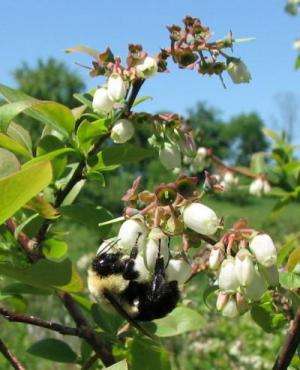As hubs for bees and pollinators, flowers may be crucial in disease transmission

Like a kindergarten or a busy airport where cold viruses and other germs circulate freely, flowers are common gathering places where pollinators such as bees and butterflies can pick up fungal, bacterial or viral infections that might be as benign as the sniffles or as debilitating as influenza.
But "almost nothing is known regarding how pathogens of pollinators are transmitted at flowers," postdoctoral researcher Scott McArt and Professor Lynn Adler at the University of Massachusetts Amherst write. "As major hubs of plant-animal interactions throughout the world, flowers are ideal venues for the transmission of microbes among plants and animals."
In a recent review in Ecology Letters with colleagues at Yale and the University of Texas at Austin, McArt and Adler survey the literature and identify promising areas for future research on how floral traits influence pathogen transmission.
As the authors point out, "Given recent concerns about pollinator declines caused in part by pathogens, the role of floral traits in mediating pathogen transmission is a key area for further research." They say their synthesis could help efforts to control economically devastating pollinator-vectored plant pathogens such as fire blight, which affects rose family fruits such as apples and pears, and mummyberry disease, which attacks blueberries.
McArt adds, "Our intent with this paper is to stimulate interest in the fascinating yet poorly understood microbial world of flowers. We found several generalities in how plant pathogens are transmitted at flowers, yet the major take-home from our paper may be in pointing out that this is an important gap in our knowledge."
The authors identified 187 studies pertaining to plant pathogens published between 1947 and 2013 in which floral visitors were implicated in transmission and where transmission must have occurred at flowers or pathogen-induced pseudoflowers. These are flower-like structures made by a pathogen that can look and smell like a real flower, for example. Regarding animal pathogens, they identified 618 studies published before September 2013 using the same criteria.
"In total, we found eight major groups of animal pathogens that are potentially transmitted at flowers, including a trypanosomatid, fungi, bacteria and RNA viruses," they note. Their paper, "Arranging the bouquet of disease: Floral traits and the transmission of plant and animal pathogens," was featured in the publisher's "News Round-Up" of "most newsworthy research."
Traditionally, research on flower evolution has focused largely on selection by pollinators, but as McArt and colleagues point out, pollinators that also transmit pathogens may reduce the benefits to the plant of attracting them, depending on the costs and benefits of pollination. The researchers say more work is needed before scientists can know whether a flower's chemical or physical traits determine the likelihood that pathogens are transmitted, for example, and whether infection by pathogens is an inevitable consequence of pollinator visitation.
"Plant pathologists have made great strides in identifying floral traits that mediate host plant resistance to floral pathogens in individual systems; synthesizing this literature can provide generality in identifying traits that mediate plant-pathogen dynamics. From the pollinator's perspective, there has been surprisingly little work elucidating the role of flowers and floral traits for pathogen transmission. Given recent concerns about pollinator declines caused in part by pathogens, understanding the role of floral traits in disease transmission is a key missing element," say McArt and colleagues.
Journal information: Ecology Letters
Provided by University of Massachusetts Amherst



















